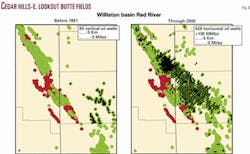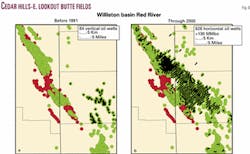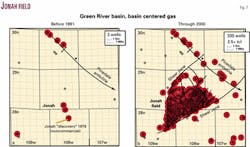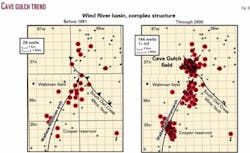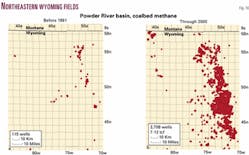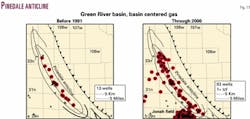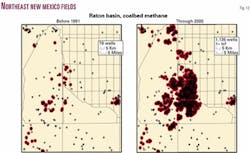An assessment of the resource pyramid appropriate for the Greater Rocky Mountain Region demonstrates a basis for predicting a large amount of potentially discoverable and exploitable hydrocarbon resources.
Further evidence justifying the prediction may be based on the recent history of exploration and development in the GRMR. There, as described in the first part of this article (OGJ, Dec. 3, 2001, p. 44), probably eight "giant" fields that contain more than 100 million bbl of oil or 1 tcf of gas have been discovered (in most cases rediscovered) in the middle to late 1990s.
These events occurred largely through the application of new technology. The fields are:
- An oil field with a hydrodynamically-tilted oil-water contact localized in a thin pay on the flank of a large regional anticline (Cedar Hills oil and gas field, Williston basin).
- An overpressured gas field where reserves were derived from an underlying and downdip regional basin centered accumulation (Jonah field, Green River basin).
- A field that contains thick columns of gas and condensate localized in a complex anticline hidden beneath a thrust plate (Cave Gulch field, Wind River basin).
- A coalbed methane field that contains a mix of thermal and biogenic gas in high-volatile coal (Greater Drunkards Wash field, western Uinta basin).
- A coalbed methane field with biogenic gas in lignite (Tongue River coals, Powder River basin).
- Basin centered, low permeability, continuous gas sands on structure (Pinedale anticline, Green River basin).
- A basin centered, low permeability, continuous gas sand (at Rulison, Mamm Creek, Cove Hollow, Buzzard, and Divide Creek fields, Piceance basin).
- A shallow biogenic coalbed methane play (Raton basin).
Details relating to geologic concepts and applied technology that led to the discovery or redevelopment of these fields are described in the following sections.
Cedar Hills field area
One giant oil field has been "discovered" in the Ordovician Red River "B" Zone in the Williston basin.
Cedar Hills-East Lookout Butte is a conventional reservoir but with a somewhat unconventional hydrodynamic trap.
The oil at Cedar Hills-East Lookout Butte field is being exploited using the same or similar horizontal drilling technology to that applied to the unconventional fractured oil reservoirs described earlier. Here the reservoir is a thin porous interval that had previously been penetrated by several completed and abandoned oil wells that were associated with noneconomic rates of production.
A porous interval (the Ordovician Red River "B" zone) is somewhat variable in thickness and extends over a large area where the oil is hydrodynamically trapped. As in all the individual cases discussed in this article, the reservoir had been drilled through and in this case had been completed noncommercially several times.
The approximate outline of Cedar Hills-East Lookout Butte field at yearend 2000 (Fig. 6b) had expanded dramatically due to the horizontally exploited Red River "B" zone compared with the pre-1990 boundary (Fig. 6a). Some 669 horizontal wells have been drilled, resulting in 626 productive completions ranging in true vertical depth from 8,800 to 9,500 ft. Estimated ultimate recovery is now expected to exceed 130 million bbl of oil.
Jonah gas field
Jonah gas field is a somewhat unique structurally controlled sweet spot within the basin centered area of the Green River basin of Wyoming.
By yearend 2000 Jonah contained over 335 wells with a per well average producible reserve of between 6 and 7 bcf.23 Fig. 7a shows the subsurface control at Jonah field in 1990 (three wells). The field was first "discovered" in 1975 by the Davis Oil Co. 1 Wardell Federal, which had an initial flow rate of 303 Mcfd of gas and 2 b/d of oil. It was later rediscovered (1985) by the Home Petroleum 1-4 Jonah Federal, tested for an initial 470 Mcfd.
Jonah was again rediscovered in 1993 when the McMurry Oil Co. 1-5 Jonah Federal tested 3.7 MMcfd and 40 b/d. The increase in production rates is attributed to improved technology in the form of better stimulation techniques.
Completion technology continues to improve so that today in a pay section similar to that found in the McMurry 1-5 Jonah Federal the initial rate might be 10 to 12 MMcfd. EUR averaged 2 bcf/well before 1994. Improved frac technology has raised the EUR steadily since 1992. For 1997 it was 6.76 bcf.24 The yearend 2000 configuration of the field contains 335 wells (Fig. 7b).
Current development has not yet established the field's eastern limit. Jonah field has a 3,000 ft gas column. Gas is trapped laterally and updip by a set of shear zones. These shear zones allow the development of a geopressured sweet spot that is some 3,000 ft higher than the top of regional deep-basin type overpressures. There is essentially no structural displacement of the main reservoir section.
The shear zones that seal the sweet spot both laterally and updip originate in the basement and have little vertical throw. However, the field itself is highly broken by faults that control anomalous overpressure displacements of as much as 600 ft in separated fault blocks within the field. This extensive internal faulting and fracturing has allowed gas to migrate vertically upward through tight rocks to a shallower reservoir, which now experiences less diagenesis and thus has higher porosity than is present in the underlying sediments associated with source rock gas generation.
Current development indicates at least 2.5 tcf recoverable.
Greater Cave Gulch field
Another giant is apparent in the locations and status of wells drilled in the Cave Gulch-Waltman-Cooper Reservoir area of the Wind River basin in Wyoming before 1991 (Fig. 8a).
The area may ultimately contain more than 1 tcf of gas reserves added since 1990, primarily because of a different geologic concept, understood by Larry McPeek, originator of the project that led to the rediscovery and major new development.
McPeek et al.16 recognized that even though Cave Gulch was a relatively small structural closure under the Owl Creek thrust plate, the fluvial depositional regime of the Fort Union (Lower Tertiary) and Lance (uppermost Cretaceous) formations would allow stacking of a thick package of sands containing complexly compartmentalized reservoirs and limited drainage areas, allowing tight spacing and multiple twins.
For instance, in one 160 acre area 16 wells are completed. In addition, McPeek recognized the deeper sands, which had proven "noncommercial" in wells drilled before 1994, to be prospective on paleostructural highs. On these highs early gas accumulation should reduce or eliminate the diagenetic destruction of reservoir quality in deeper reservoirs. New fracturing technology has also played a significant role in successfully stimulating these deeper zones.
Cave Gulch field and the resulting Waltman Trend have had some 109 shallow (3,000 to 10,000 ft) and 12 deep (17,000 to 23,000 ft) wells drilled since 1994. The yearend 2000 extent of the trend is shown in Fig. 8b. Current development has established a maximum net pay section of 1,300 ft. One deep well blew out, and its calculated absolute open flow potential was 1 bcfd.
Drunkards Wash, Utah
Drilling was spotty in the Greater Drunkards Wash gas area before 1991 (Fig. 9a).
At yearend 2000, 996 wells were producing. An aggressive drilling program is projected for the foreseeable future.
Buzzards Bench coalbed methane field had one well in 1993. It now has over 110. It appears that the entire area between Drunkards Wash and Buzzards Bench fields will eventually be productive (Fig. 9b).
Lamarre and Burns25 found that the average coal thickness in Drunkards Wash field is 24 ft. One well that has been producing over 5 years from a 28 ft thick coal has cumulative production of more than 3.5 bcf and was producing 1,461 Mcfd and 369 b/d of water in 2000. The first 33 wells producing over a 65 month period averaged just under 1 MMcfd and 85 b/d of water.
The average per well daily gas production has increased 380% while water production decreased 80%. None of these wells had begun to decline after 51/2 years of continuous production.
Considering the current and projected number of development wells, it seems reasonable to assume that the Greater Drunkards Wash area, including Buzzards Bench, may eventually yield over 3 tcf.
Powder River basin coals
Another coalbed methane giant gas field is being rapidly developed in the Powder River basin (Fig. 10a).
With more than 40 rigs running and plans for as many as 1,000 wells/year, this play is in a state of explosive development.
We can be assured that this giant field developing in the Tongue River coal member of the Paleocene Fort Union formation, which ranges from 300 to 1,200 ft in depth, will give up well over 6 tcf. Estimates with a range from as much as 7 to 25 tcf have been made.26 27
Pinedale anticline
This field has been a sleeping giant for many years.
On an obvious giant structure, the tight gas reservoirs defeated early attempts to exploit them. Some 13 subcommercial gas and oil wells were completed before 1991.
Recent drilling has demonstrated the existence of numerous sweet spots on the structure (Fig. 11). The pattern is again unfolding with "discoveries" completed in the same Upper Cretaceous Lance formation productive at Jonah field. This production is now spreading along the anticline's entire 50 mile length.
Pinedale and Jonah will undoubtedly link up eventually. As Jonah has grown downdip, the two fields-one a proven giant and one a "sleeping giant"-will merge.
Raton basin coalbed gas
Early drilling in the Raton basin was unsuccessful for conventional gas reservoirs. However, in the late 1980s a few coalbed methane wells had been tried with marginal success.
As new stimulation and completion technology became available in the mid-1990s a rapid explosion took place in the development of biogenic gas in the Vermejo and Raton coals.
The basin had some 79 completions at yearend 1990 (Fig. 12a), and this rose to 1,135 completions and locations by yearend 2000.
The Vermejo coal wells will average 1.6 bcf/well, while the Raton coals will average 1 bcf/well. The basin's newly developing fields are growing into one giant field (Fig. 12b). It is reasonable to speculate that this field will eventually yield well over 1 tcf.
Piceance basin
The Piceance basin has a long history of marginally economic lower volume gas wells in Lower Cretaceous formations.
Drainage was initially thought to be 80 acres/well. Through time it became apparent because of the fluvial character of the reservoirs that drainage was more like 20 acres.
During the past 10 years a great deal of step-out drilling and infill drilling have added significant reserves. The Rulison, Mamm Creek, Cave Hollow, Buzzard, and Divide Creek field area (Fig. 13a) contained 559 wells at the end of 1990. This number had increased to 1,541 wells (Fig. 13b) at yearend 2000.
As these fields merge it is clear another giant is in the making, and Dea27 suggests several trillion cubic feet of gas will be recovered.
References
The authors
Ray Thomasson has 42 years of technical and business experience in oil and gas exploration. He served as head strategic planning, Shell International (London), and planning, forecasting, and economics, Shell US; and chief geologist, Shell US. He is founder and owner of Thomasson Partner Associates Inc., a private oil and gas exploration company involved in global exploration projects. He has BA and MA degrees from the University of Missouri and a PhD degree from the University of Wisconsin. [email protected]
Fred F. Meissner has worked extensively in the Rocky Mountains, Europe, the South Pacific, South America, Canada, and Mexico with Shell, Sohio/BP, and several independents. He is an adjunct professor of geology at the Colorado School of Mines and a member of Thomasson Partner Associates Inc. He has geological engineering and master of science degrees from CSM and more than 40 years' experience in oil and gas exploration.
